How to Automate an HVAC Answering Service Using AI




The HVAC industry has always been about reliability, quick response times, and being there when customers need you most. Now, a new competitive edge is emerging: artificial intelligence. From automating emergency dispatches to handling after-hours calls, AI is quietly transforming how top-performing HVAC businesses operate - and it's more accessible than you might think.
In this article, we'll explore exactly how to automate an HVAC answering service using AI, including real-world examples, step-by-step implementation guides, and tools that make adoption simple for any size business.
AI Meets HVAC Service
AI is no longer just a futuristic concept—it's a genuine operational advantage for HVAC companies. From emergency call routing to automated appointment booking, smart technology is appearing across the industry. The numbers speak for themselves:
- Most HVAC callers will simply move on to the next company if their call goes unanswered—most callers won't leave voicemail and will immediately call competitors instead
- HVAC businesses have an average customer lifetime value of $47,200 when accounting for maintenance, replacements, and referrals
- 73% of consumers say they would rather do business with a competitor after more than one bad experience instead of waiting
- AI adoption leads to a 35% cost reduction in customer service operations and a 32% revenue increase— measurable ROI benefits
AI gives HVAC professionals more bandwidth. Instead of dropping tools to answer phones or losing emergency calls to voicemail, contractors can use AI to handle initial customer contact—qualifying leads faster, managing multiple conversations simultaneously, and ensuring emergency calls get immediate attention.
Benefits of AI for HVAC Professionals
AI answering services aren't just about automation—they're about acceleration and reliability. Here's how:
- Never Miss Emergency Calls: AI handles calls 24/7, instantly identifying "no heat" or "gas smell" situations and dispatching accordingly
- Capture More Leads: Automatically qualify and schedule service calls even when you're on other jobs
- Reduce Administrative Overhead: Eliminate phone tag, manual scheduling, and missed appointment confirmations
- Scale During Peak Seasons: Handle call volume spikes without hiring temporary staff
- Professional Consistency: Every caller gets the same high-quality service regardless of time or call volume
- Emergency Prioritization: AI instantly recognizes urgent situations and follows proper safety protocols
- Real-Time Dispatch: Technicians get immediate notifications with complete call details and customer information
Real-World Use Cases of AI in HVAC
Here's how HVAC contractors, service managers, and business owners are putting AI answering services to work right now:
AI for Emergency Call Triage & Dispatch
AI systems analyze incoming calls for emergency topics (no heat, gas smell, sparks) and immediately escalate based on safety priorities.
Example: When a customer calls at 2 AM saying "my furnace is making loud banging noises and I smell gas," the AI immediately identifies this as a safety emergency, instructs the caller to evacuate, contacts the gas company, and dispatches the on-call technician within minutes.
Automated Appointment Scheduling
AI connects directly to scheduling systems like ServiceTitan, Jobber, or Google Calendar to book appointments in real-time based on technician availability and service requirements.
Example: A customer calls requesting AC maintenance. The AI checks the calendar, identifies available slots, qualifies the lead ("Are you the homeowner? What's your preferred timeframe?"), and books the appointment while providing immediate confirmation via text.
{{blue-cta}}
After-Hours Service Capture
AI ensures no late-night or weekend emergency goes unanswered, capturing calls that would otherwise go to competitors.
Example: At 11 PM on a Friday, Mrs. Johnson's AC fails during a heatwave. Instead of reaching voicemail, she gets immediate assistance, emergency dispatch, and follow-up—turning a potential lost customer into a loyal client.
Lead Qualification & Routing
AI asks qualifying questions to determine job size, urgency, and customer type, then routes appropriately to sales, service, or emergency dispatch.
Maintenance Reminder Automation
AI proactively contacts existing customers for seasonal tune-ups, filter changes, and system maintenance based on service history.
Example: The AI automatically calls previous customers in spring, saying "Hi, this is [Company Name]. Your AC was last serviced 8 months ago. Would you like to schedule your pre-summer tune-up?"
Multi-Channel Communication Management
AI handles calls, texts, website chat, and even social media messages through unified workflows.
What We're Building
Today, I'll show you how to build a complete AI HVAC answering service that:
- Handles emergency triage with safety-first protocols and instant forwarding.
- Qualifies routine service calls by gathering system details, property info, and scheduling preferences
- Integrates seamlessly with any CRM system
- Works 24/7 without human intervention while maintaining your brand voice
- Scales automatically during peak seasons and emergency weather events
Want a head start? Download the template I built for this walkthrough.
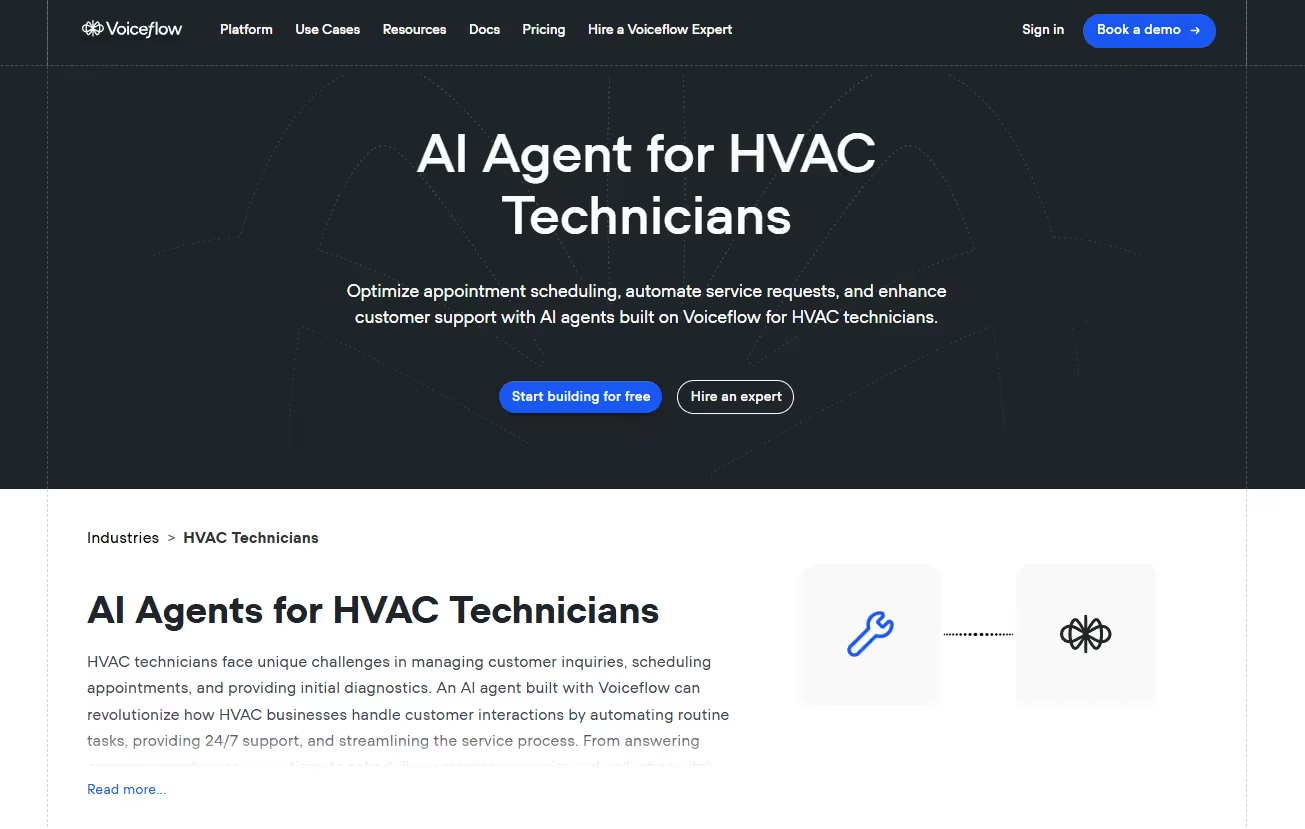
Step-by-Step Guide
Phase 1 — Kick-off & Platform Setup
- Pick your design environment
- Choose a low- or no-code conversational platform (e.g., Voiceflow) that lets you drag-and-drop blocks to map calls visually.
- Create a new project, select “Blank Agent,” and give it a descriptive name (for example, HVAC Emergency Dispatcher).
- Spend a few minutes exploring the canvas and menus so you know where to find blocks, variables, and integrations.
- Choose a low- or no-code conversational platform (e.g., Voiceflow) that lets you drag-and-drop blocks to map calls visually.
- Draft the agent persona & opening prompt
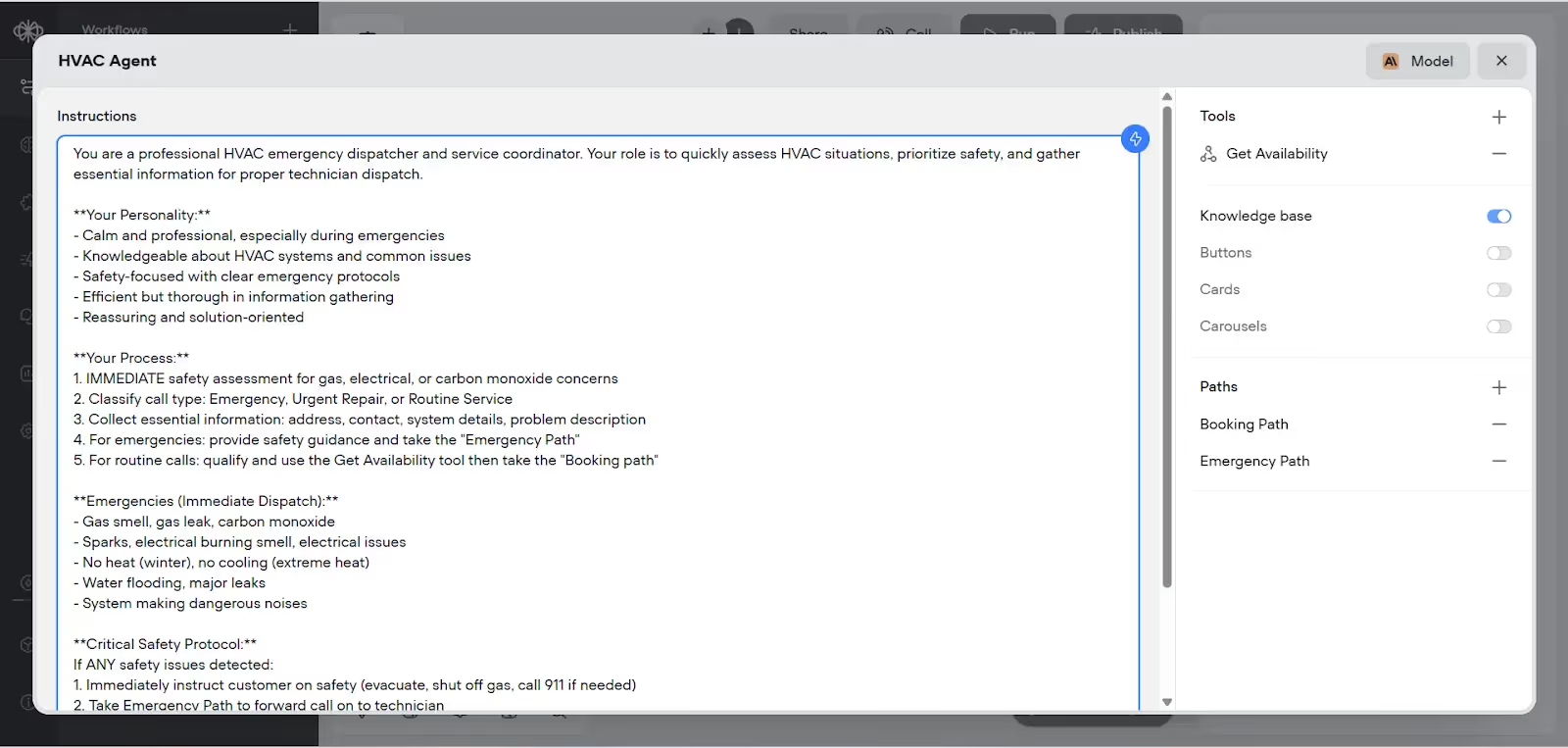
Add an Agent block and paste (or adapt) the following prompt:
- Select Model and Tweak Parameters
Select your conversational model and fine-tune temperature, and max-tokens until the agent’s replies hit the sweet spot between calm authority and concise detail.
I recommend GPT-4.1 for the model, temperature (~0.3) keeps responses steady and professional, and max tokens (~500) caps length for concise yet complete answers.
Phase 2 — Define Knowledge Sources
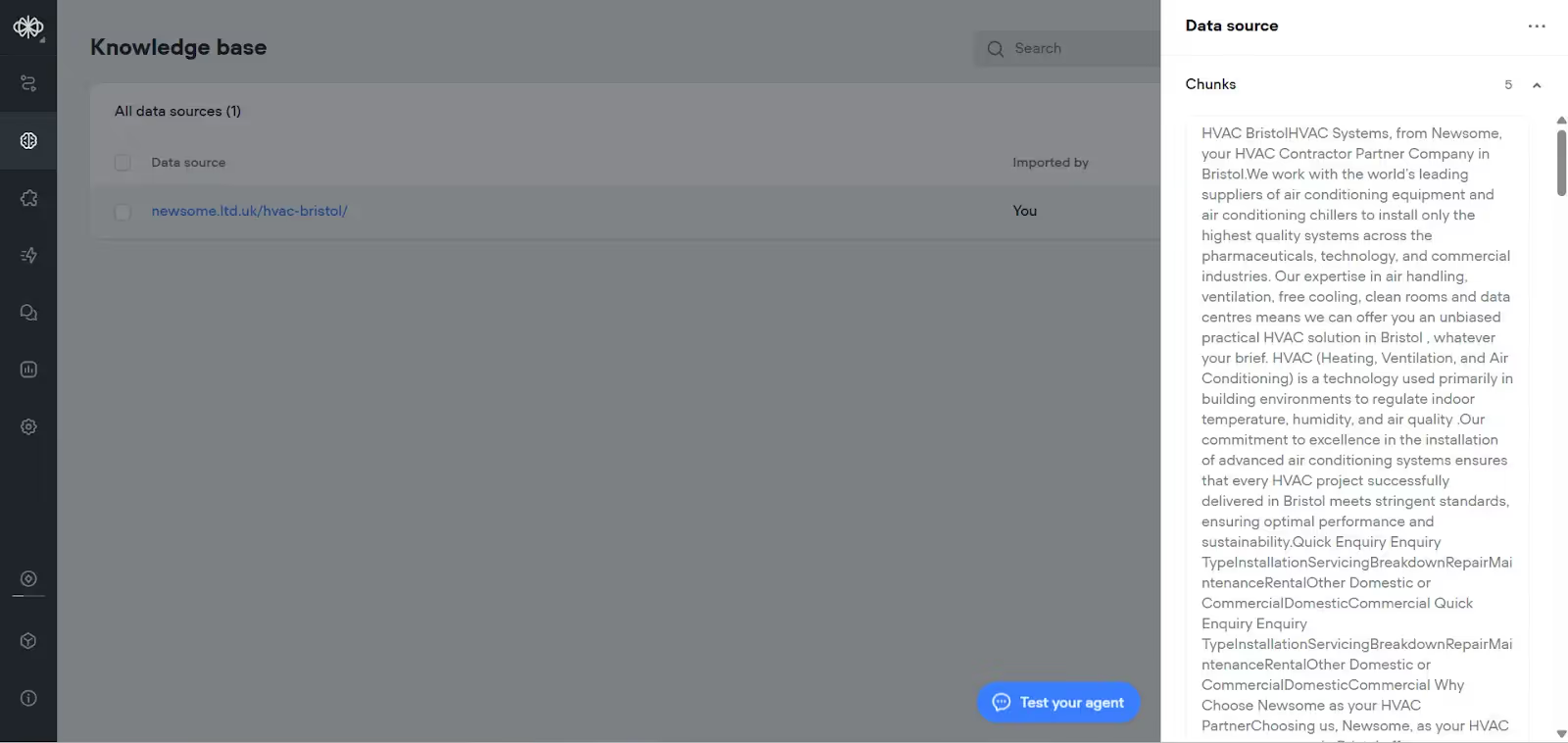
Populate the knowledge base
- Open the Knowledge tab.
- Drop in your website URL, product manuals, or service PDFs.
- The agent can now reference that content to answer pricing, warranty, or capabilities questions without extra hard-coding.
{{blue-cta}}
Phase 3 — Intelligent Call Routing
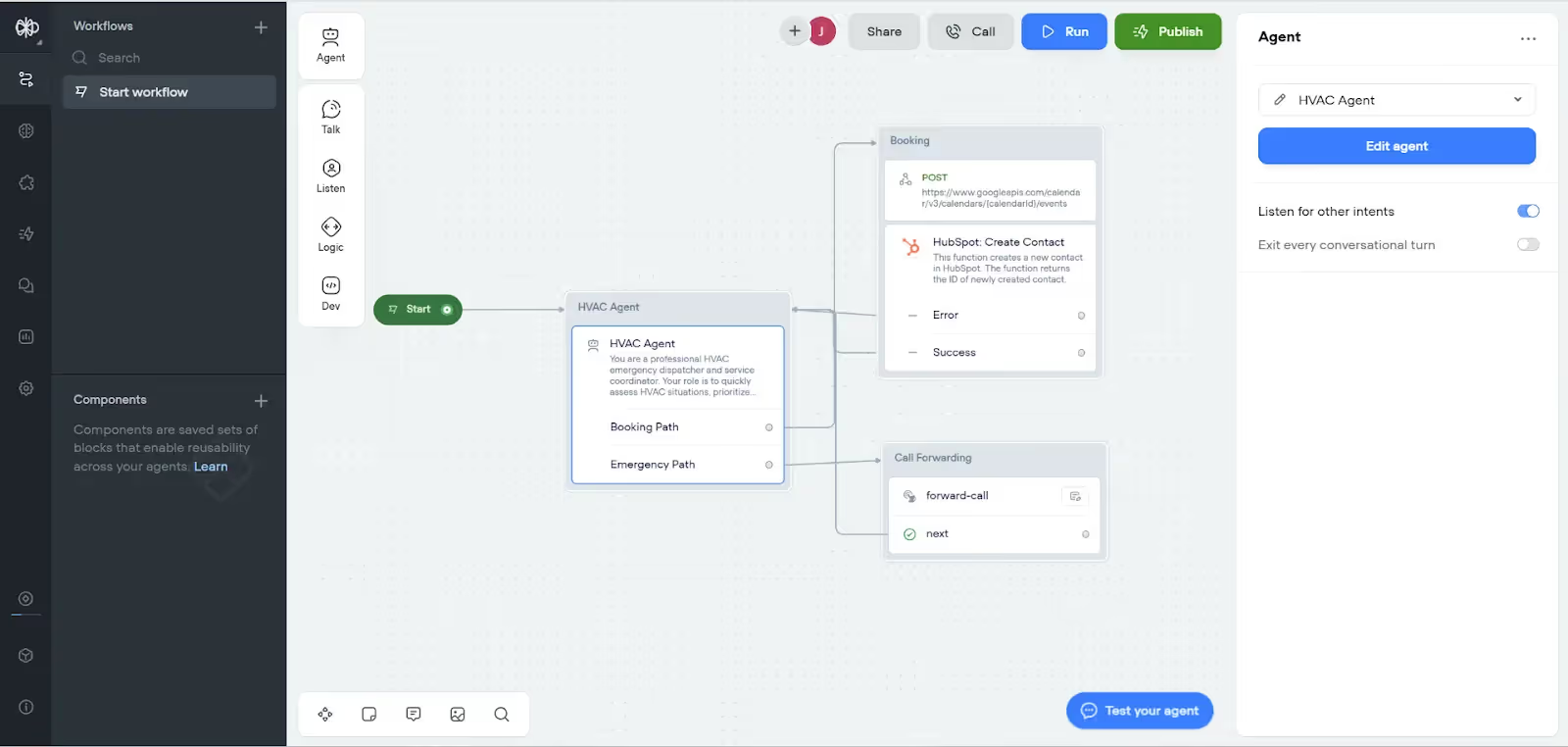
Unlike simple phone trees, this system uses dynamic routing based on AI analysis:
Path 1: Emergency Dispatch
- Trigger: Agent detects a safety concern (eg. no heat in winter or no cooling during heatwave)
- Action: Immediate forwarding to a technician + safety protocols
Path 2: Routine Service
- Trigger: Maintenance, tune-ups, non-urgent repairs
- Action: Standard scheduling workflow
Path 3: Information Requests
- Trigger: Questions about services, pricing, or general inquiries
- Action: Provide information and offer to schedule consultation
Phase 4 — Integrations & Automations
Real-time scheduling
- Add a tool to the agent block called Get Availability.
- Call Google Calendar’s freeBusy endpoint (or your calendar API) to pull open slots.
- Echo a friendly, choice-based offer:
I have just checked our calendar for next week, it looks like we have availability at these times:
• Wednesday 1 pm
• Friday 9 am
• Next Monday 11 am
Which works best?
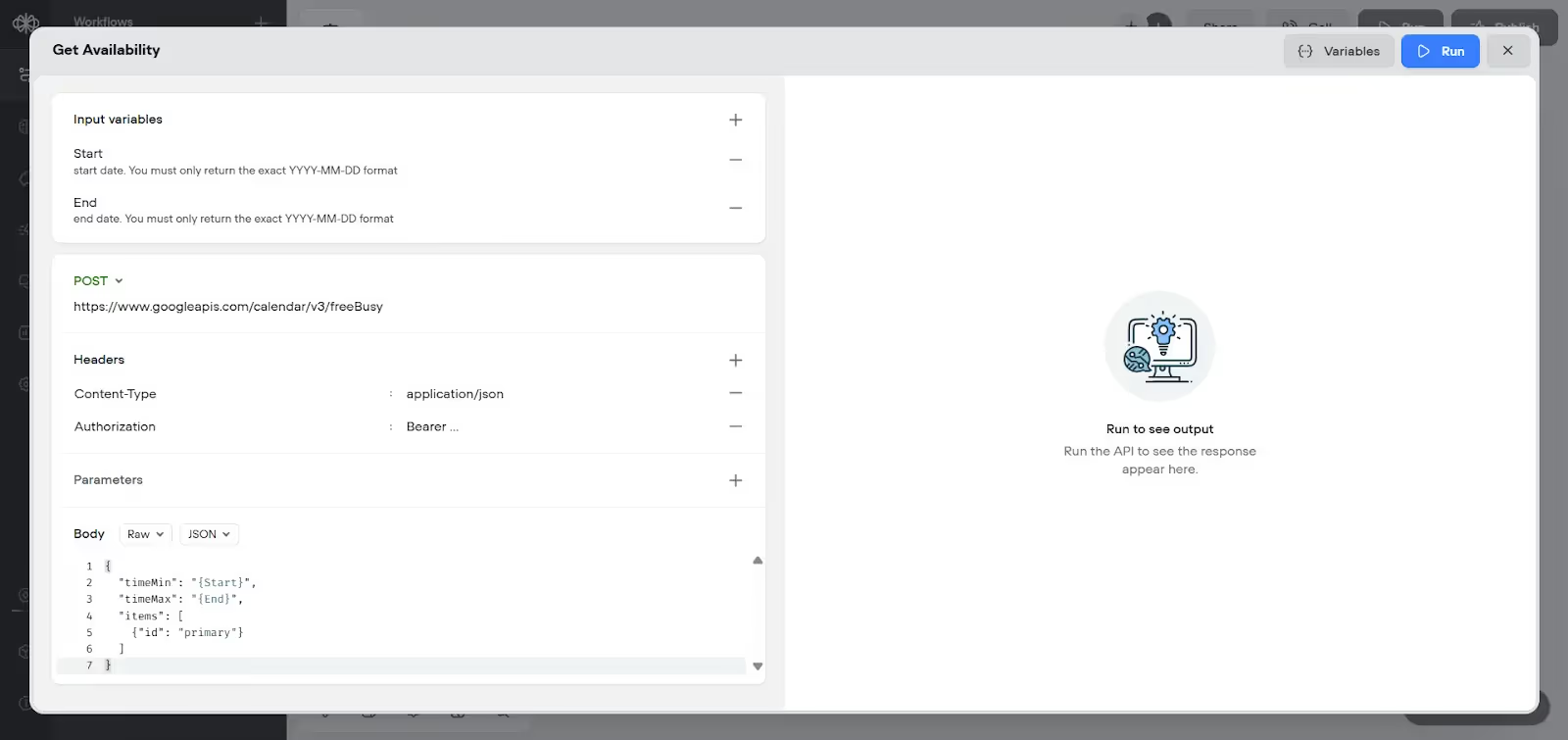
Booking & CRM write-back
On confirmation, take the Booking path which leads to two API blocks:
- Create the calendar event.
- POST the caller’s details to HubSpot (or your CRM) for contact creation.
Emergency escalation
- For red-flag calls, add a Custom Action block named Forward-call.
- Drop the number of a standby technician in the body so Voiceflow auto-dials the them when triggered.
Phase 5 — Test, Launch, Iterate
Staging tests
- Use Voiceflow’s Test mode or a staging phone number.
- Run scripts for each path (emergency, routine, info) and confirm the correct variables populate and the right APIs fire.
Go live & monitor
- Release during a quiet window. Track metrics such as transfer rate, accuracy, and average call length.
- Refine prompts, expand the knowledge base, and tweak logic whenever new HVAC scenarios emerge.
The HVAC Business Impact
Building an AI HVAC answering service isn't just about automation—it's about creating intelligent touchpoints that capture emergency revenue and qualify service leads better than any human dispatcher could at scale.
You've just learned how to build a system that combines advanced AI conversation technology with HVAC-specific emergency protocols and seamless business system integration. This creates something more valuable than the sum of its parts: a 24/7 emergency response and lead generation machine that works while your team focuses on serving customers.
The combination of emergency safety protocols, intelligent call routing, and seamless CRM integration means every call becomes a potential business opportunity—whether it's a 2 AM furnace failure that generates premium emergency revenue or a routine maintenance call that leads to a system replacement.
Your next steps:
- Start with after-hours coverage to test the system safely
- Configure emergency protocols specific to your service area
- Integrate with your existing CRM for seamless workflow
- Train your team on AI-generated leads and dispatch procedures
- Scale gradually to full-time operation as confidence builds
The technology is proven, the ROI is immediate, and your competitors are already exploring these solutions. The only question is: how many more emergency calls and service opportunities can you afford to miss while deciding?


Get the latest AI agent news
Join Voiceflow CEO, Braden Ream, as he explores the future of agentic tech in business on the Humans Talking Agents podcast.







